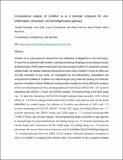Computational analysis of Urolithin A as a potential compound for anti-inflammatory, antioxidant, and neurodegenerative pathways

View/
Date
2025-02-01Author
Massaga, Caroline
Paul, Lucas
Kwiyukwa, Lucas
Vianney, John-Mary
Chacha, Musa
Raymond, Jofrey
Metadata
Show full item recordAbstract
Urolithin A, an active precursor derived from the metabolism of ellagitanins in rats and humans, is known for its potential health benefits, including stimulating mitophagy and promoting muscular skeletal function. While experimental studies have demonstrated Urolithin A's potential to enhance cellular health, the detailed molecular interactions through which Urolithin A exerts its effects are not fully elucidated. In this study, we investigated the anti-inflammatory, antioxidation and neuroprotective abilities of Urolithin A in selected targets using molecular docking and molecular dynamics simulation methods. Molecular docking studies revealed the strong affinity for receptors involved in inflammation activities, including human p38 MAP kinase (4DLI) with −10.1 kcal/mol interacting with SER252, LYS249, and ASP294 residues. The binding energy in the 5KIR target was −8.6 kcal/mol, interacting with GLN203 through hydrogen bond, and lastly, 1A9U with an affinity of −6.8 with no hydrogen bond formed with Urolithin A and interacts with van der Waals interactions. In oxidant targets, the influence of Urolithin was observed in 1OG5 with −7.9 kcal/mol interacting with GLN185, PHE447. For the 1M17 target, the binding affinity was −7.7 kcal/mol interacting with THR95 residue and 1ZXM target at −7.4 kcal/mol interacting with TYR36, TYR216, and LEU234 residues. The neuroprotective ability of urolithin A was observed in selected targets for acetylcholinesterase; the binding energy was −9.7 kcal/mol interacting with van der Waals and π interactions; for the 1GQR target, the binding energy was −9.9 kcal/mol interacting with van der Waals and π interactions and for β-amylase (1iyt) the binding energy was −5.5 forming hydrogen bond with SER8, GLN15 residues. Molecular Dynamics simulations at 100 ns of Urolithin A compared with reference 4DLI. The Urolithin A-4DLI complex exhibited greater stability than the reference receptor, as confirmed by RMSD, RMSF, Radius of Gyration, Hydrogen bond, and SASA analyses.
URI
https://doi.org/10.1016/j.freeradbiomed.2024.12.003https://dspace.nm-aist.ac.tz/handle/20.500.12479/2961
